Themed collection 2021 Materials Chemistry Frontiers HOT articles

A tri-component semiconducting polymer with ultrahigh photothermal conversion efficiency as a biodegradable photosensitizer for phototheranostics
Semiconducting polymers usually with high photostability, reactive oxygen species (ROS) generation ability and photothermal conversion efficiency hold tremendous promise for phototherapy.

Mater. Chem. Front., 2022,6, 8-14
https://doi.org/10.1039/D1QM01236C
BiVO4 nanofiber-based field-effect transistors for detection of epinephrine/adrenaline hormones
In this work, an ultrasensitive-BioFET (biosensor field-effect transistor) is developed for chemiresistive, label-free detection of epinephrine hormone in urine samples.
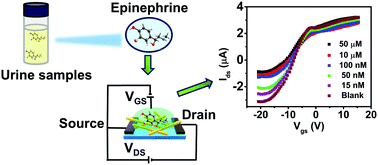
Mater. Chem. Front., 2021,5, 8281-8289
https://doi.org/10.1039/D1QM01274F
A synergistic self-assembly strategy to fabricate thermally stable OPAN/PI composite aerogels for particulate matter removal
The development of low-cost nanofiber aerogels with good mechanical and thermal properties is essential for practical applications in the fields of heat insulation, air filtration, etc.

Mater. Chem. Front., 2021,5, 8308-8318
https://doi.org/10.1039/D1QM00974E
Atomic Fe–N5 catalytic sites embedded in N-doped carbon as a highly efficient oxygen electrocatalyst for zinc–air batteries
FeN5–C/G with the atomic dispersion of Fe–N5 sites was synthesized by a simple method and exhibited enhanced ORR activity in Zn–air batteries compared with commercial 20% Pt/C.

Mater. Chem. Front., 2021,5, 8127-8137
https://doi.org/10.1039/D1QM00809A
Modulating the multiple intrinsic properties of platinum–iron alloy nanowires towards enhancing collaborative electrocatalysis
The electrocatalytic properties of an alloy can be effectively controlled by adjusting their inherent physical and chemical performance (compositions, lattice strain, facets, etc.) to provide a better surface structure and compositions for efficient electrocatalytic reactions in the cathode and anode of fuel cells.

Mater. Chem. Front., 2021,5, 8118-8126
https://doi.org/10.1039/D1QM01136G
sp-Hybridized nitrogen doped graphdiyne for high-performance Zn–air batteries
The sp-hybridized nitrogen atoms (sp-N) have been site-specifically doped into graphdiyne (GDY). The precisely constructed sp-N doped GDY displays superior electrocatalytic activity for Zn–air batteries.

Mater. Chem. Front., 2021,5, 7987-7992
https://doi.org/10.1039/D1QM01137E
Carving the shell thickness of tungsten trioxide hollow multi-shelled structures for enhanced photocatalytic performance
Precise carving of the shell thickness of hollow multi-shelled structures (HoMSs) is achieved with the tuning of shell numbers. The effect of shell thickness on the physico-chemical properties and photocatalytic performance of WO3 HoMSs is revealed.

Mater. Chem. Front., 2021,5, 8010-8017
https://doi.org/10.1039/D1QM01124C
Confining lead-free perovskite quantum dots in metal–organic frameworks for visible light-driven proton reduction
Lead-free perovskite quantum dots are introduced into metal–organic framework photocatalysts through an anti-solvent recrystallization method for high photocatalytic performance under visible light.

Mater. Chem. Front., 2021,5, 7796-7807
https://doi.org/10.1039/D1QM01006A
Porous polyimide framework based on perylene and triazine for reversible potassium-ion storage
A porous polyimide framework was prepared via condensation between perylenetetracarboxylic dianhydride and triazine and investigated as an electrode material for reversible K+-ion storage. It exhibited a large reversible capacity, good rate performance, and long cycling stability up to 1000 cycles at 5 A g−1.
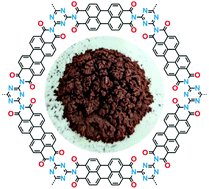
Mater. Chem. Front., 2021,5, 7184-7190
https://doi.org/10.1039/D1QM00843A
Anchoring Zn0.5Cd0.5S solid solution onto 2D porous Co–CoO nanosheets for highly improved photocatalytic H2 generation
Two-dimensional porous Co–CoO nanosheets act as an efficient cocatalyst to reduce the HER overpotential and boost the charge separation of Zn0.5Cd0.5S nanocrystals.
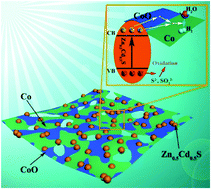
Mater. Chem. Front., 2021,5, 7208-7215
https://doi.org/10.1039/D1QM00669J
Improving the performance of all-inorganic perovskite light-emitting diodes through using polymeric interlayers with a pendant design
Despite demonstrating better photoluminescence quantum yield and ambient/operational stability than organic–inorganic hybrid perovskites, all-inorganic perovskites encounter the problem of inferior film quality and interfacial electrical properties.

Mater. Chem. Front., 2021,5, 7199-7207
https://doi.org/10.1039/D1QM01027A
Naphthalene-diimide-based all-conjugated block copolymer as an effective compatibilizer to improve the performance and thermal stability of all-polymer solar cells
A new donor–acceptor-type all-conjugated block copolymer, P(NDI-DBDT)-b-P(NDI-2T), is synthesized through the coupling of a naphthalene diimide (NDI)-bithiophene segment-based polymer and an NDI-dithienylbenzodithiophene (DBDT) segment-based polymer.
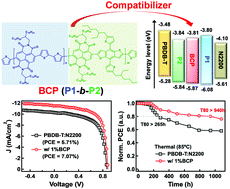
Mater. Chem. Front., 2021,5, 7216-7227
https://doi.org/10.1039/D1QM00859E
Controllable synthesis of multidimensional carboxylic acid-based NiFe MOFs as efficient electrocatalysts for oxygen evolution
Controllable synthesis of multidimensional carboxylic acid-based NiFe MOFs is realized by a simple solvent-assisted strategy as efficient electrocatalysts for oxygen evolution.
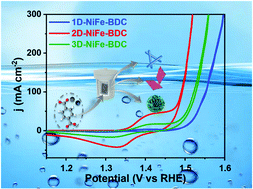
Mater. Chem. Front., 2021,5, 7191-7198
https://doi.org/10.1039/D1QM00960E
Highly sensitive detection of paraquat with pillar[5]arenes as an aptamer in an α-hemolysin nanopore
We report a highly sensitive biological nanopore sensor by introducing carboxylatopillar[5]arene (CP[5]A) molecule as an aptamer into the lumen of αHL nanopore for the single-molecule detection of paraquat (PQ) via host–guest interactions.
![Graphical abstract: Highly sensitive detection of paraquat with pillar[5]arenes as an aptamer in an α-hemolysin nanopore](/en/Image/Get?imageInfo.ImageType=GA&imageInfo.ImageIdentifier.ManuscriptID=D1QM00875G&imageInfo.ImageIdentifier.Year=2021)
Mater. Chem. Front., 2021,5, 7032-7040
https://doi.org/10.1039/D1QM00875G
Modulating the kinetics of CoSe2 yolk–shell spheres via nitrogen doping with high pseudocapacitance toward ultra-high-rate capability and high-energy density sodium-ion half/full batteries
Uniform nitrogen-doped CoSe2 yolk–shell spheres with improved electrochemical kinetics have been synthesized, which deliver excellent sodium storage performance in terms of ultra-high-rate capability and long cycling durability.

Mater. Chem. Front., 2021,5, 6873-6882
https://doi.org/10.1039/D1QM00608H
Facial synthesis of two-dimensional In2S3/Ti3C2Tx heterostructures with boosted photoactivity for the hydrogenation of nitroaromatic compounds
In this work, Ti3C2Tx (MXene) acts as the platform for directing the growth of 2D In2S3 nanoflakes, thereby generating 2D In2S3/Ti3C2Tx heterostructures, which exhibited boosted photocatalytic activities compared to bare In2S3.
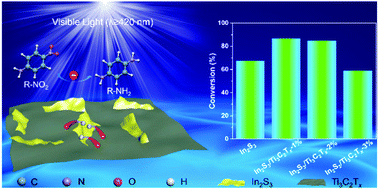
Mater. Chem. Front., 2021,5, 6883-6890
https://doi.org/10.1039/D1QM00844G
Hierarchical C/Co3O4 nanoarray on a nickel substrate integrating electromagnetic and thermal shielding
A hierarchical C/Co3O4 nanoarray integrating excellent electromagnetic and thermal shielding performance can be used to assemble wearable devices to protect human beings from electromagnetic and thermal radiation.
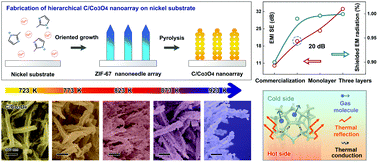
Mater. Chem. Front., 2021,5, 6553-6558
https://doi.org/10.1039/D1QM00731A
An anthracene based conjugated triazine framework as a luminescent probe for selective sensing of p-nitroaniline and Fe(III) ions
An anthracene based conjugated triazine framework (DPA-CTF) has been constructed as a luminescent probe for selective sensing of p-nitroaniline and Fe(III) ions.
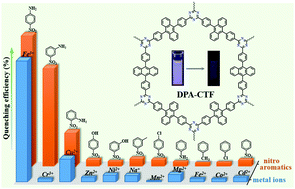
Mater. Chem. Front., 2021,5, 6568-6574
https://doi.org/10.1039/D1QM00686J
Simple glycerol-assisted and morphology controllable solvothermal synthesis of CeVO4/BiVO4 hierarchical hollow microspheres with enhanced photocatalytic activities
CeVO4/BiVO4 heterostructures were synthesized and achieved a significantly improved photocatalytic efficiency towards MB under visible-light irradiation.

Mater. Chem. Front., 2021,5, 6522-6529
https://doi.org/10.1039/D1QM00770J
Silica-nanoresin crosslinked composite polymer electrolyte for ambient-temperature all-solid-state lithium batteries
A novel poly(vinyl ethylene carbonate) based composite polymer electrolyte using a cellulose membrane as a separator, adding a NR acting as both a silica filler and ETPTA crosslinker, and eventually constructing a crosslinked structure with a high modulus.
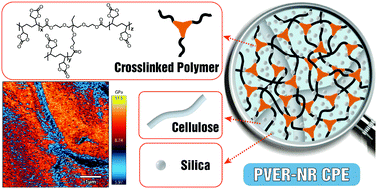
Mater. Chem. Front., 2021,5, 6502-6511
https://doi.org/10.1039/D1QM00769F
Donor–acceptor based two-dimensional covalent organic frameworks for near-infrared photothermal conversion
Two 2D COFs containing both electron acceptors and donors were prepared successfully. The charge-transfer process results in distinct near-infrared absorption properties which make them good NIR photothermal materials.
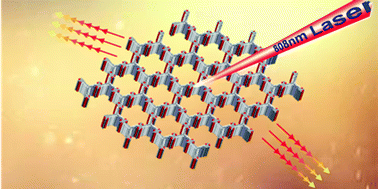
Mater. Chem. Front., 2021,5, 6575-6581
https://doi.org/10.1039/D1QM00462J
Sulfonic acid functionalized graphitic carbon nitride as solid acid–base bifunctional catalyst for Knoevenagel condensation and multicomponent tandem reactions
A highly efficient, non-toxic, metal-free, low-cost, acid–base bifunctional sulfonated graphitic carbon nitride (S-g-C3N4) nanosheets for Knoevenagel condensation and multicomponent tandem reactions under environmentally benign conditions.
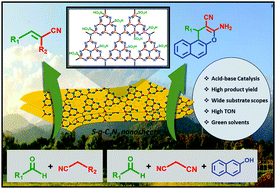
Mater. Chem. Front., 2021,5, 6265-6278
https://doi.org/10.1039/D1QM00650A
A large-bandgap copolymer donor for efficient ternary organic solar cells
A 2.18 eV bandgap copolymer donor C1 was developed for efficient ternary organic solar cells.
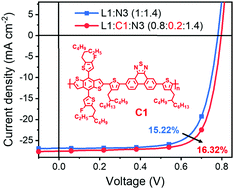
Mater. Chem. Front., 2021,5, 6139-6144
https://doi.org/10.1039/D1QM00835H
High-power graphene supercapacitors for the effective storage of regenerative energy during the braking and deceleration process in electric vehicles
The practical applicability of a high-power graphene supercapacitor as an effective primary and auxiliary energy storage system for storing regenerative energy from the braking and deceleration process in electric vehicles (EVs) is studied.
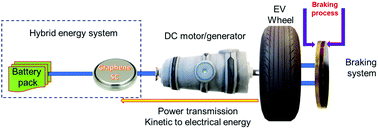
Mater. Chem. Front., 2021,5, 6200-6211
https://doi.org/10.1039/D1QM00465D
Triple-responsive targeted hybrid liposomes with high MRI performance for tumor diagnosis and therapy
Targeted multi-responsive drug delivery systems with magnetic resonance imaging (MRI) capacity were anticipated as a promising tool for tumor therapy and diagnosis.
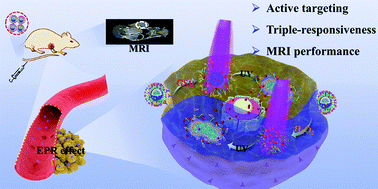
Mater. Chem. Front., 2021,5, 6226-6243
https://doi.org/10.1039/D1QM00788B
Self-trapped exciton to dopant energy transfer in Sb3+-doped Cs2ZrCl6 perovskite variants
The study on the doping in perovskites and perovskite variants become a hot issue, which can provide a feasible way for modulating the electronic and photoluminescence properties and structural stability.
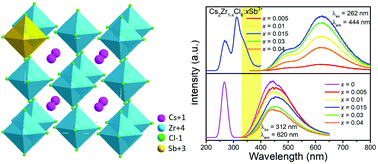
Mater. Chem. Front., 2021,5, 6133-6138
https://doi.org/10.1039/D1QM00697E
Regulating the adsorption behavior of intermediates on Ir–W@Ir–WO3−x boosts acidic water oxidation electrocatalysis
The activity and stability toward acidic water oxidation on Ir–W@Ir–WO3−x can be boosted by regulating the adsorption behavior of oxygen-containing intermediates.
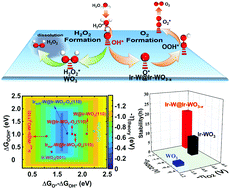
Mater. Chem. Front., 2021,5, 6092-6100
https://doi.org/10.1039/D1QM00551K
Graphdiyne–hemin-mediated catalytic system for wound disinfection and accelerated wound healing
The well-dispersed and biosafe hemin/graphdiyne (GDY) nanocomposite (GDY–hemin) exhibits high peroxidase activity, which can decompose H2O2 to generate highly-toxic hydroxyl radicals, leading to bacterial death in both in vitro and in vivo.
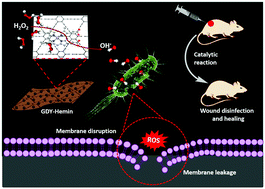
Mater. Chem. Front., 2021,5, 6041-6051
https://doi.org/10.1039/D1QM00490E
Fluorescence resonance energy transfer enhanced photothermal and photodynamic antibacterial therapy post a single injection
The constructed near-infrared photothermal nanoparticles (NDIA@PEG-Ce6/B NPs) can enhance the photothermal performance through the FRET effect and can achieve excellent photothermal and photodynamic antibacterial treatment post a single injection.
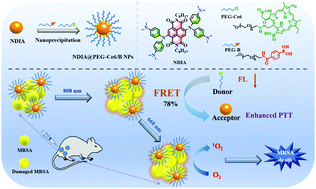
Mater. Chem. Front., 2021,5, 6061-6070
https://doi.org/10.1039/D1QM00631B
Formation of a lead chalcogenide quantum dot-based supramolecular polymer network via pillar[5]arene-based host–guest complexation
We presented the construction of a lead chalcogenide quantum dot-based fluorescent supramolecular polymer network driven by pillar[5]arene-based host–guest complexation.
![Graphical abstract: Formation of a lead chalcogenide quantum dot-based supramolecular polymer network via pillar[5]arene-based host–guest complexation](/en/Image/Get?imageInfo.ImageType=GA&imageInfo.ImageIdentifier.ManuscriptID=D1QM00699A&imageInfo.ImageIdentifier.Year=2021)
Mater. Chem. Front., 2021,5, 5833-5840
https://doi.org/10.1039/D1QM00699A
Highly efficient solution-processed pure yellow OLEDs based on dinuclear Pt(II) complexes
Two efficient dinuclear Pt(II) complexes SO-DPt and AB-DPt were developed by employing diphenylsulfone and arylboron groups. The resultant emitters exhibited pure yellow electroluminescence in solution-processed OLEDs with EQEs exceeding 21%.
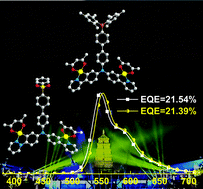
Mater. Chem. Front., 2021,5, 5698-5705
https://doi.org/10.1039/D1QM00507C
Ionic conductivity and dielectric properties of bulk SPP-PEG hydrogels as Na+ ion-based SPE materials for energy storage applications
A non-flammable, non-hazardous, eco-friendly polymeric hydrogel material with a floating sandwiched layer was prepared by a green chemistry method for energy storage applications.
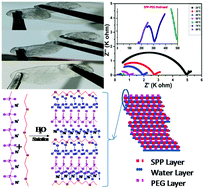
Mater. Chem. Front., 2021,5, 5857-5866
https://doi.org/10.1039/D1QM00537E
Photoactive conjugated polymer/graphdiyne nanocatalyst for CO2 reduction to CO in living cells for hypoxia tumor treatment
A photoactive conjugated polymer/graphdiyne nanocatalyst was developed for the in situ reduction of CO2 to CO for hypoxia tumor treatment.
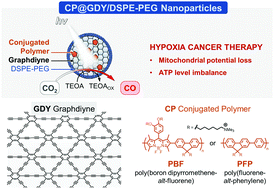
Mater. Chem. Front., 2021,5, 5841-5845
https://doi.org/10.1039/D1QM00677K
Silk fibroin microspheres as optical resonators for wide-range humidity sensing and biodegradable lasers
Silk fibroin, a naturally abundant and eco-friendly material, is successfully transformed into discrete, well-defined microspherical particles that function as an active optical resonator for precise moisture sensing over a wide humidity range.
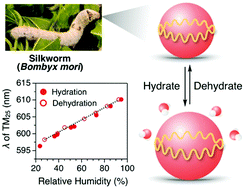
Mater. Chem. Front., 2021,5, 5653-5657
https://doi.org/10.1039/D1QM00451D
Asymmetric small organic molecule-based NIR-II fluorophores for high performance tumor phototheranostics
High performance phototheranostic agents based on a single-component asymmetric small organic molecule were successfully constructed for NIR-II fluorescence imaging-guided photothermal/photodynamic therapy.
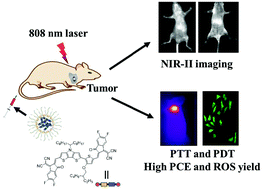
Mater. Chem. Front., 2021,5, 5689-5697
https://doi.org/10.1039/D1QM00472G
Ordered mesoporous ZnGa2O4 for photocatalytic hydrogen evolution
Ordered large-pore mesoporous ZnGa2O4 with ultrathin crystalline frameworks of 3–5 nm for photocatalytic hydrogen evolution.

Mater. Chem. Front., 2021,5, 5790-5797
https://doi.org/10.1039/D1QM00593F
Increasing the surface area and CO2 uptake of conjugated microporous polymers via a post-knitting method
A facile post-knitting method was developed to increase the surface area of conjugated microporous polymers for improving the CO2 adsorption ability.
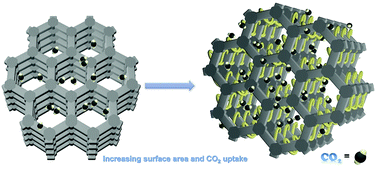
Mater. Chem. Front., 2021,5, 5319-5327
https://doi.org/10.1039/D1QM00371B
A glutathione-activated carrier-free nanodrug of triptolide as a trackable drug delivery system for monitoring and improving tumor therapy
The chemical structure of CyssTP and its self-assembly into a glutathione-activated carrier-free nanodrug of triptolide (CyssTPN) as a trackable drug delivery system for tumor therapy.
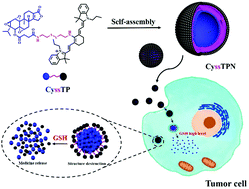
Mater. Chem. Front., 2021,5, 5312-5318
https://doi.org/10.1039/D1QM00400J
Graphdiyne@NiOx(OH)y heterostructure for efficient overall water splitting
A new GDY@NiOx(OH)y heterostructure was synthesized by creatively incorporating GDY with NiOx(OH)y for efficient water splitting. The mixed valence states and facilitated charge transfer behavior significantly improve the catalytic activity.
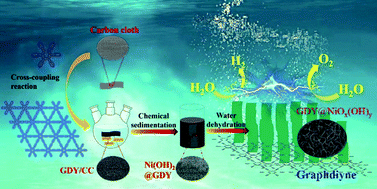
Mater. Chem. Front., 2021,5, 5305-5311
https://doi.org/10.1039/D1QM00466B
Constructing a stable interface between the sulfide electrolyte and the Li metal anode via a Li+-conductive gel polymer interlayer
An in situ derived Li+-conductive gel polymer interlayer enables intimate solid–solid contact and uniform Li+ flux at the Li/Li10GeP2S12 heterointerface and effectively inhibits interfacial reactions and Li dendrite growth.
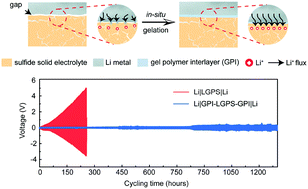
Mater. Chem. Front., 2021,5, 5328-5335
https://doi.org/10.1039/D1QM00395J
Rational design of aqueous conjugated polymer nanoparticles as potential theranostic agents of breast cancer
Aqueous conjugated polymer nanoparticles developed by nanoprecipitation from a quinoxaline–thiophene type conjugated polymer with 3 fluorine atoms as potential cancer theranostics for breast cancer.
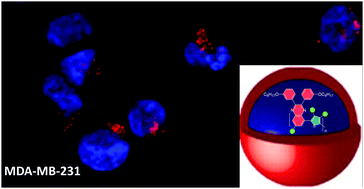
Mater. Chem. Front., 2021,5, 4950-4962
https://doi.org/10.1039/D1QM00479D
Electrochemical fixation of CO2 over a Mo plate to prepare a Mo2C film for electrocatalytic hydrogen evolution
Electrochemical reduction of CO2 over a metal substrate integrates fixation of CO2 and surface carbonization of the metal to functional films.
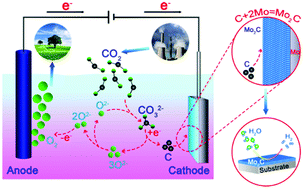
Mater. Chem. Front., 2021,5, 4963-4969
https://doi.org/10.1039/D1QM00443C
Research on metallic chalcogen-functionalized monolayer-puckered V2CX2 (X = S, Se, and Te) as promising Li-ion battery anode materials
Two-dimensional MXene nanomaterials are promising anode materials for Li-ion batteries (LIBs) due to their excellent conductivity, large surface area, and high Li capability.
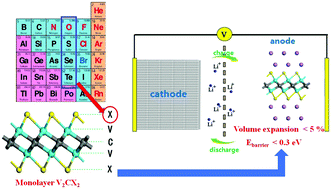
Mater. Chem. Front., 2021,5, 4672-4681
https://doi.org/10.1039/D1QM00422K
Synthesis and fundamental studies of a photoresponsive oligonucleotide-upconverting nanoparticle covalent conjugate
A greener route to a photocleavable phosphoramidite was used to synthesize an alkyne-containing oligonucleotide and conjugated to an azide-modified upconverting nanoparticle. The conjugation, energy transfer, and photocleavage were evaluated.
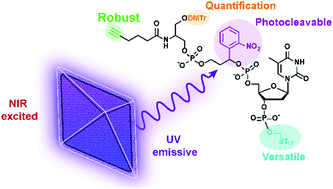
Mater. Chem. Front., 2021,5, 4690-4699
https://doi.org/10.1039/D1QM00467K
Ceria doping boosts methylene blue photodegradation in titania nanostructures
The photocatalytic activity of titania nanotubes and nanoparticles toward methylene blue (MB) can be enhanced through addition of a small amount of Ce. MB acts as a hole scavenger, fastening the photocatalytic process.
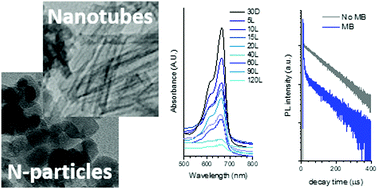
Mater. Chem. Front., 2021,5, 4138-4152
https://doi.org/10.1039/D1QM00068C
Controllable growth of graphdiyne layered nanosheets for high-performance water oxidation
Developing highly active, stable and low-cost electrocatalysts capable of an efficient oxygen evolution reaction (OER) is urgent and challenging.
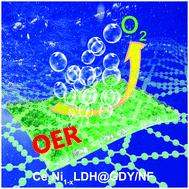
Mater. Chem. Front., 2021,5, 4153-4159
https://doi.org/10.1039/D1QM00132A
Hydrogen bond induced high-performance quaternary organic solar cells with efficiency up to 17.48% and superior thermal stability
We present a novel quaternary OSCs by doping SR197 and PC71BM into a host system (PM6:Y6) to achieve a PCE of up to 17.48%. And the intermolecular hydrogen bonds between materials are formed to directionally modulate the film morphology.

Mater. Chem. Front., 2021,5, 3850-3858
https://doi.org/10.1039/D1QM00197C
Carbon-incorporated Fe3O4 nanoflakes: high-performance faradaic materials for hybrid capacitive deionization and supercapacitors
Here, we introduce a new strategy using urea for the synthesis of carbon-incorporated 2D Fe3O4 (2D-Fe3O4/C) nanoflakes which show superior potential for hybrid capacitive deionization and supercapacitors.
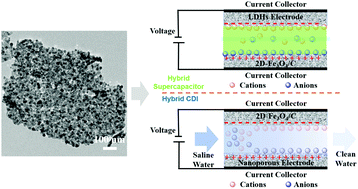
Mater. Chem. Front., 2021,5, 3480-3488
https://doi.org/10.1039/D0QM00946F
A dentin hypersensitivity treatment using highly stable photothermal conversion nanoparticles
A type of photothermal biocompatible organic nanoparticles with a high PCE (40.6%) was developed and investigated, followed by the achievement of a significantly more effective phototheranostic dental hypersensitivity treatment combined with laser.
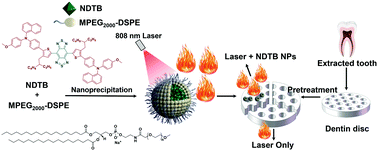
Mater. Chem. Front., 2021,5, 3388-3395
https://doi.org/10.1039/D0QM01006E
Stencil mask defined doctor blade printing of organic single crystal arrays for high-performance organic field-effect transistors
A novel printing method to realize a solution processed large-area, high-resolution organic single crystal array for OFET applications.
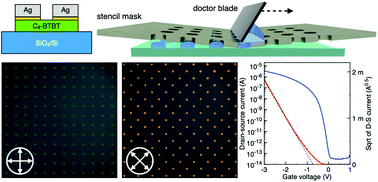
Mater. Chem. Front., 2021,5, 3236-3245
https://doi.org/10.1039/D1QM00097G
A near-infrared AIE probe for super-resolution imaging and nuclear lipid droplet dynamic study
A near-infrared AIE probe was developed for super-resolution imaging and nuclear lipid droplets dynamic study with good biocompatibility and high photostability.
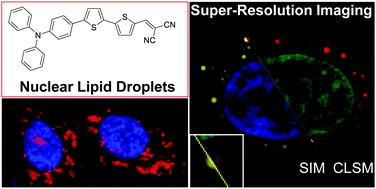
Mater. Chem. Front., 2021,5, 3043-3049
https://doi.org/10.1039/D0QM00914H
DNA nanolantern as biocompatible drug carrier for simple preparation of a porphyrin/G-quadruplex nanocomposite photosensitizer with high photodynamic efficacy
DNA nanolanterns, a pure DNA assembly, are used as biocompatible drug carriers to prepare a nanocomposite photosensitizer for highly efficient photodynamic therapy in the biological transparent window.
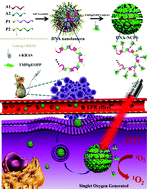
Mater. Chem. Front., 2021,5, 3139-3148
https://doi.org/10.1039/D1QM00141H
Enabling photocatalytic activity of [Ru(2,2′:6′,2′′-terpyridine)2]2+ integrated into a metal–organic framework
A multicomponent metal–organic framework is constructed to incorporate the bis-terpyridyl ruthenium motif, which was considered poorly photoactive, through a stepwise reticular synthesis to arouse its photosensitiveness for producing singlet oxygen.
![Graphical abstract: Enabling photocatalytic activity of [Ru(2,2′:6′,2′′-terpyridine)2]2+ integrated into a metal–organic framework](/en/Image/Get?imageInfo.ImageType=GA&imageInfo.ImageIdentifier.ManuscriptID=D1QM00024A&imageInfo.ImageIdentifier.Year=2021)
Mater. Chem. Front., 2021,5, 2777-2782
https://doi.org/10.1039/D1QM00024A
An aqueous rechargeable lithium ion battery with long cycle life and overcharge self-protection
Zn2+ added into electrolyte can effectively suppress H2 evolution. Therefore, a LiMn2O4/NaTi2(PO4)3 full cell exhibits enhanced overcharging performance and excellent cycling stability up to 10 000 cycles.
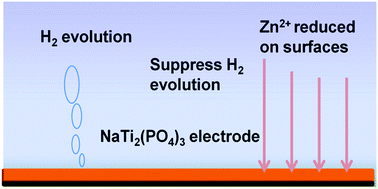
Mater. Chem. Front., 2021,5, 2749-2757
https://doi.org/10.1039/D0QM01117G
Glycolide additives enrich organic components in the solid electrolyte interphase enabling stable ultrathin lithium metal anodes
Glycolide (GL) is proposed as an electrolyte additive to prolong the cycle life of ultrathin Li metal anodes through the enrichment of the organic components in the working solid electrolyte interphase.
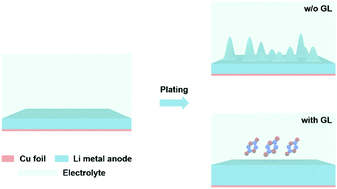
Mater. Chem. Front., 2021,5, 2791-2797
https://doi.org/10.1039/D0QM01134G
A 2D porphyrin-based covalent organic framework with TEMPO for cooperative photocatalysis in selective aerobic oxidation of sulfides
This work reports the cooperative photocatalysis of a two-dimensional covalent organic framework with an electron transfer mediator in a selective organic transformation.
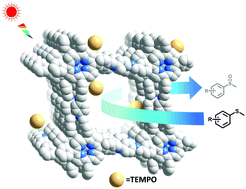
Mater. Chem. Front., 2021,5, 2255-2260
https://doi.org/10.1039/D0QM01076F
Full-type photoluminescence from a single organic molecule for multi-signal temperature sensing
Full-type photoluminescence including concomitant fluorescence, delayed fluorescence, and room-temperature phosphorescence from a single organic molecule is used for multi-signal temperature sensing.
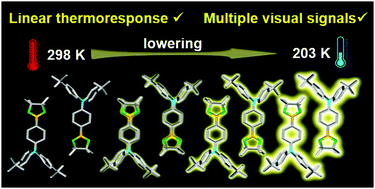
Mater. Chem. Front., 2021,5, 2261-2270
https://doi.org/10.1039/D1QM00023C
PET-RAFT facilitated 3D printable resins with multifunctional RAFT agents
The application of reversible addition–fragmentation chain-transfer (RAFT) agents in stereolithographic 3D printing has been seldom reported due to their tendency to reduce polymerization rates.

Mater. Chem. Front., 2021,5, 2271-2282
https://doi.org/10.1039/D0QM00961J
Sensitive and specific detection of peroxynitrite and in vivo imaging of inflammation by a “simple” AIE bioprobe
A facile synthesized AIE bioprobe was developed to detect peroxynitrite sensitively and specifically. This bioprobe can realize both in vitro ONOO− detection and in vivo visualization of inflammation.
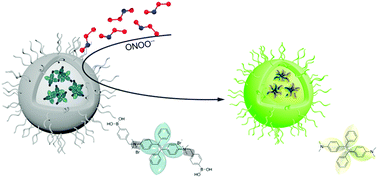
Mater. Chem. Front., 2021,5, 1830-1835
https://doi.org/10.1039/D0QM01004A
An easily available ratiometric AIE probe for nitroxyl visualization in vitro and in vivo
An easily available ratiometric fluorescent probe (TCFPB-HNO) with aggregation-induced emission (AIE) characteristics was developed for the first time for the detection and visualization of nitroxyl (HNO) in vitro and in vivo.
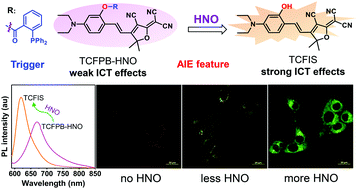
Mater. Chem. Front., 2021,5, 1817-1823
https://doi.org/10.1039/D0QM00995D
Diagnosis of fatty liver disease by a multiphoton-active and lipid-droplet-specific AIEgen with nonaromatic rotors
We present a two-photon AIEgen, ABCXF with nonaromatic rotors (–CF3), a high two-photon absorption cross-section, bright red emission in the solid-state, and remarkably high photostability for fatty liver disease diagnosis.
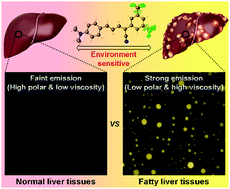
Mater. Chem. Front., 2021,5, 1853-1862
https://doi.org/10.1039/D0QM00877J
Photo-triggered Zn2+ release for the regulation of zinc enzymes
A photo-triggered Zn2+ release system was developed based on HBTH–Zn–TAT NPs, which showed an excellent light-dependent “on–off” performance for Zn2+ release and the precise regulation of extra- and intracellular zinc enzyme activities.
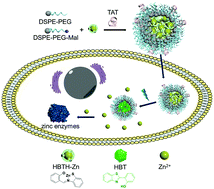
Mater. Chem. Front., 2021,5, 1824-1829
https://doi.org/10.1039/D0QM00947D
Polymer light-emitting electrochemical cells with ultralow salt content: performance enhancement through synergetic chemical and electrochemical doping actions
This work demonstrates that PLECs made with a low AgOTf salt concentration exhibit record luminance, efficiency, lifetime and response speed.
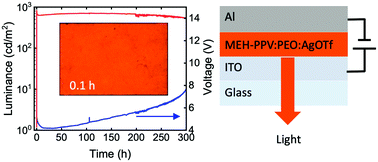
Mater. Chem. Front., 2021,5, 1847-1852
https://doi.org/10.1039/D0QM00937G
Synthesizing alkynyl-decorated 2D conjugated nonfullerene acceptors for efficient polymer solar cells
Two 2D conjugated nonfullerene acceptors featured the conjugation of π-electrons of ethynyl side-chain and backbone, leading to enhanced absorptivity and downshifted energy levels, and showed around 16% efficiencies when employed as acceptor guests.
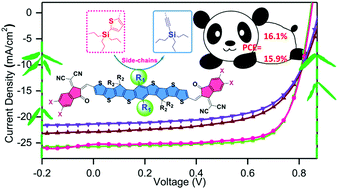
Mater. Chem. Front., 2021,5, 1836-1846
https://doi.org/10.1039/D0QM00882F
About this collection
Read our on-going collection of the hottest research published as advanced article from Materials Chemistry Frontiers in 2021. These articles are recommended by reviewers as being of significant novelty and interest. Congratulations to all the authors whose articles are featured!